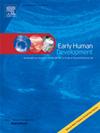使用期等值年龄MRI预测点状白质病变早产儿的运动预后
IF 2
3区 医学
Q2 OBSTETRICS & GYNECOLOGY
引用次数: 0
摘要
本研究评估了足月等效年龄(TEA-MRI)的磁共振成像(MRI)是否与早产MRI一样具有预测性,当使用白质成像规则时,该规则根据点状白质病变(PWMLs)在横切面上的位置在心室中线前方或后方进行评分。此外,我们评估了PWMLs的数量及其在冠状面和矢状面中的位置。方法回顾性研究41例妊娠32周的PWMLs早产儿,在TEA-MRI上进行随访,随访时间为矫正后2年和/或5-8岁。对所有平面的扫描结果进行分析,使用标准化测试评估随访情况。结果41例患儿中有18例(44%)出现不良运动预后,6例发生脑瘫(CP)。在横切面,13/21(62%)的PWMLs患儿有不良预后,6例(29%)有CP。在冠状面,11/18(61%)的病变穿过内囊后肢,有不良运动预后,5例(28%)有CP。在矢状面,11/14(79%)的病变穿过中央沟,有不良运动预后,6例(43%)有CP。横切面中脑室中线前的病变可预测不良的运动预后。矢状面中央沟受累具有最高的预测价值。结论将早产儿MRI白质成像规律应用于TEA-MRI对运动预后也有预测价值。相对于矢状面中央沟的PWML位置最能预测不良的运动预后。本文章由计算机程序翻译,如有差异,请以英文原文为准。
Prediction of motor outcome in preterm infants with punctate white matter lesions using term equivalent age MRI
Introduction
This study assessed whether magnetic resonance imaging (MRI) at term equivalent age (TEA-MRI) is as predictive as preterm MRI, when using a white matter imaging rule which scores punctate white matter lesions (PWMLs) according to their location anterior or posterior to the midventricular line in a transverse plane. In addition, we assessed the number of PWMLs and their location in the coronal and sagittal planes.
Methods
Retrospective study, 41 preterm neonates <32 weeks' gestation with PWMLs on TEA-MRI and follow-up at two years corrected and/or 5–8 years of age. Scans were analysed in all planes, follow-up was assessed using standardized tests.
Results
18/41 infants (44 %) had adverse motor outcome, six had cerebral palsy (CP). In the transverse plane, 13/21 (62 %) infants with PWMLs anterior to the midventricular line, had adverse outcome and six (29 %) CP. In the coronal plane, 11/18 (61 %) with lesions crossing the posterior limb of internal capsule, had adverse motor outcome and five (28 %) CP. In the sagittal plane, 11/14 (79 %) infants with lesions crossing the central sulcus, had adverse motor outcome and six (43 %) CP. On the TEA-MRI, lesions anterior to the midventricular line in the transverse plane were predictive of adverse motor outcome. Involvement of the central sulcus in the sagittal plane had the highest predictive value.
Conclusion
The white matter imaging rule on preterm MRI is also of predictive value for motor outcome when used on the TEA-MRI. PWML location relative to the central sulcus in the sagittal plane was most predictive of adverse motor outcome.
求助全文
通过发布文献求助,成功后即可免费获取论文全文。
去求助
来源期刊

Early human development
医学-妇产科学
CiteScore
4.40
自引率
4.00%
发文量
100
审稿时长
46 days
期刊介绍:
Established as an authoritative, highly cited voice on early human development, Early Human Development provides a unique opportunity for researchers and clinicians to bridge the communication gap between disciplines. Creating a forum for the productive exchange of ideas concerning early human growth and development, the journal publishes original research and clinical papers with particular emphasis on the continuum between fetal life and the perinatal period; aspects of postnatal growth influenced by early events; and the safeguarding of the quality of human survival.
The first comprehensive and interdisciplinary journal in this area of growing importance, Early Human Development offers pertinent contributions to the following subject areas:
Fetology; perinatology; pediatrics; growth and development; obstetrics; reproduction and fertility; epidemiology; behavioural sciences; nutrition and metabolism; teratology; neurology; brain biology; developmental psychology and screening.
 求助内容:
求助内容: 应助结果提醒方式:
应助结果提醒方式:


